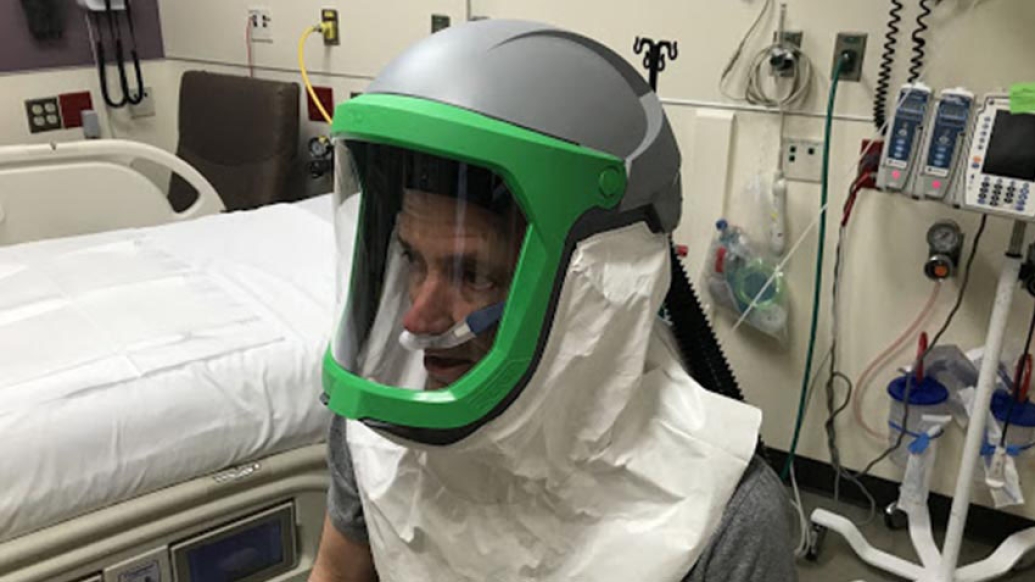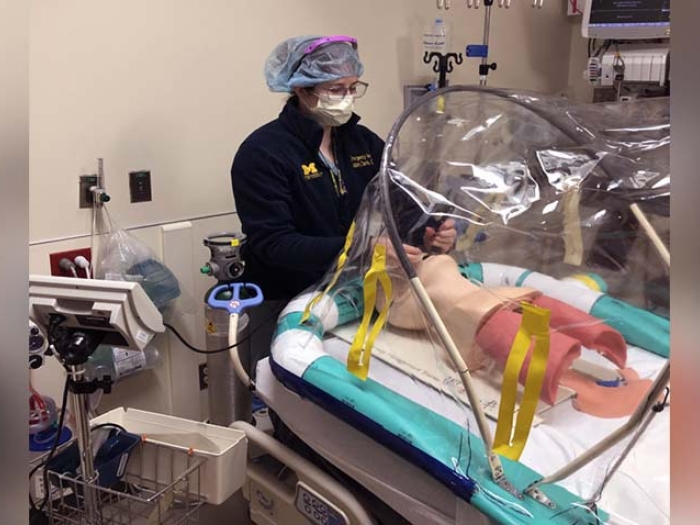Researchers from the University of Michigan have developed a helmet solution to provide support for COVID-19 patients, protect health care workers and safeguard hospital systems.
10:45 AM
Author |

Editor's note: Information on the COVID-19 crisis is constantly changing. For the latest numbers and updates, keep checking the CDC's website. For the most up-to-date information from Michigan Medicine, visit the hospital's Coronavirus (COVID-19) webpage.
Interested in a COVID-19 clinical trial? Health research is critical to ending the COVID-19 pandemic. Our researchers are hard at work to find vaccines and other ways to potentially prevent and treat the disease and need your help. Sign up to be considered for a clinical trial at Michigan Medicine.
This article was adapted from an original article written by Megan VanStratt of MCIRCC.
As intensive care units and emergency rooms around the world see increasing numbers of patients with COVID-19, resource management and control of transmission are two of the greatest challenges faced by providers.
"Rapidly depleting supplies of personal protective equipment (PPE), dwindling access to negative pressure rooms and limited stock of mechanical ventilators pose a threat to patients and a strain on health care systems," says Kevin Ward, M.D., a professor of emergency medicine and executive director of the Michigan Center for Integrative Research in Critical Care (MCIRCC).
To help with the COVID-19 pandemic, University of Michigan researchers have developed a new, portable and mass-producible helmet system that can potentially transform any hospital bed into a negative pressure room, while protecting caregivers, and sparing ventilators for the most critical cases.
LISTEN UP: Add the new Michigan Medicine News Break to your Alexa-enabled device, or subscribe to our daily updates on iTunes, Google Play and Stitcher.
Built largely from commercially-available parts, the innovation's compact design effectively isolates COVID-19 positive patients and allows for more liberal use of aggressive respiratory treatments, while decreasing the risk of potential exposure to the virus to health care providers.
"This is a creative solution that has been re-engineered to protect health care workers, spare ventilators and allow therapies to be delivered outside of negative pressure rooms, which are expensive to build and a limited resource in health systems," says Benjamin Bassin, M.D., an assistant professor of emergency medicine at Michigan Medicine, director of the Joyce and Don Massey Family Foundation Emergency Critical Care Center (EC3), and one of the team members leading the project.
The idea for the device was cultivated by a team of engineers and clinicians, led by Ward and Sridhar Kota, Ph.D., a professor of mechanical engineering at U-M.
"Initial discussions were inspired by an astronaut's helmet with a hose," Kota says. "We knew we needed to completely enclose the nose and mouth so that everything the wearer is breathing is contained."
They worked for weeks, creating prototypes out of a store bought vacuum cleaner motor and various different helmets. The device they landed on utilizes existing industrial products to create a personal negative pressure environment wherever the patient is located, and it maintains that environment even if the patient requires movement, such as imaging, testing, use of the restroom or transport.
The system draws oxygen, as well as room air, into the helmet, while pulling exhaled air and any other outflow through a high efficiency particulate air (HEPA) filter, clearing it of the virus. The research team says it is lightweight, disposable and has a retractable face shield, allowing easy access to the mouth for food and hygienic needs.
"Our understanding has evolved rapidly as we've gotten more experience with the disease," Bassin says. "We now know that patients infected with COVID-19 will present with severe hypoxia, or low levels of oxygen in their bloodstream. Delivering heated high flow nasal cannula oxygen, which is 60 liters of oxygen per minute to the nasal and oral cavity, might spare or delay the need for a ventilator, or may allow them to be liberated from a ventilator earlier."
Bassin adds this could afford more ventilators to those who urgently need them.
The research team says one challenge with the heated high flow nasal cannula oxygen treatment, and some other respiratory therapies, is that they may result in aerosolization, or the production of airborne particles and tiny liquid droplets of the virus, putting health care workers at a higher risk of exposure.
"Clinicians were concerned about the use of heated high flow nasal cannula in patients with COVID-19 due to potential risk of aerosolization, so some avoided those therapies and put patients on ventilators early," Bassin says. "We were potentially not using an additional tool in our arsenal against the disease that could help patients because of the risks to health care workers."
"Protecting health care workers is always a top priority," says Nathan Haas, M.D., an instructor of emergency medicine at Michigan Medicine and member of the project team. "But right now our health care system faces strain from potentially losing health care providers, and innovative and creative strategies to circumvent that shortage are desperately needed."
The isolation provided by the helmet enables the use of heated high flow nasal cannula and nebulized medication therapies, sparing the need for a mechanical ventilator, while also removing the risk of aerosolization and transmission of the virus to the outside environment.
This is a creative solution that has been re-engineered to protect health care workers, spare ventilators and allow therapies to be delivered outside of negative pressure rooms.Ben Bassin, M.D.
Beyond patients with severe respiratory issues, the system is also envisioned to be used for less critical COVID-19 infected patients who require hospitalization where no negative pressure rooms are available. This includes places like crowded emergency departments where suspected COVID-19 infected patients are being tested, or in places of confinement, such as an ambulance, medical helicopter or an aircraft carrier.
The research team first tested the device on healthy fellow clinicians in the emergency department in order to explore factors such as comfort, ability to speak and functionality. After their feedback and modifications, it was tested in patient care, under a supervised protocol, to understand patient tolerability and to get feedback from patients and health care providers.
MORE FROM MICHIGAN: Sign up for our weekly newsletter
"Getting it to the first patient quickly was very helpful," Haas says. "We received excellent feedback from the patient, as well as from providers in nursing, respiratory therapy and those physically providing care at the bedside."
Bassin adds, "Based on the patient encounter and testing to date, it does what it was designed to do and appears to be successful."
From the intensive care unit perspective, "The negative pressure helmet is an incredibly innovative device which will immediately fill a significant and urgent need," says Lena Napolitano, M.D., director of the U-M Surgical Intensive Care Unit and an associate director at MCIRCC. "This novel device will greatly benefit patients with COVID-19 and other aerosol-transmitted diseases, and will also aid in protection of health care workers by preventing disease transmission."
The device is currently undergoing refinement and additional testing before it could be made widely available.
The MCIRCC team is working with U-M Tech Transfer to secure patent protection, and is seeking expedited review under the EUA FDA guidelines in conjunction with manufacturing partners. U-M Tech Transfer is working closely with industry partners to find solutions to scale production in order to meet the needs of the current pandemic and beyond.
"My goal is to put as many of these units into the hands of caregivers as fast as humanly possible," Kota adds.

Explore a variety of health care news & stories by visiting the Health Lab home page for more articles.

Department of Communication at Michigan Medicine
Want top health & research news weekly? Sign up for Health Lab’s newsletters today!





